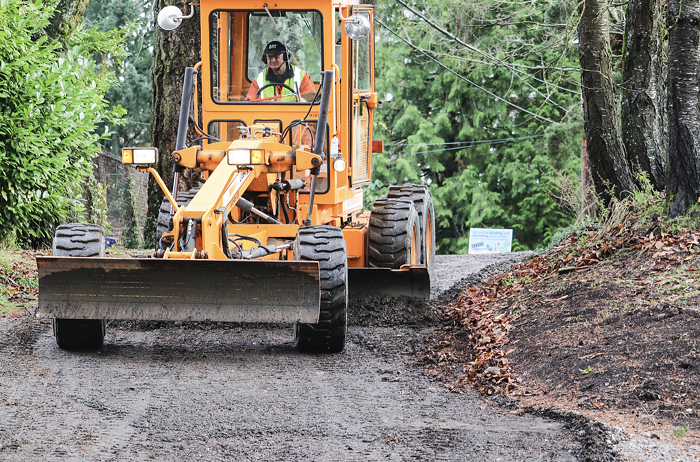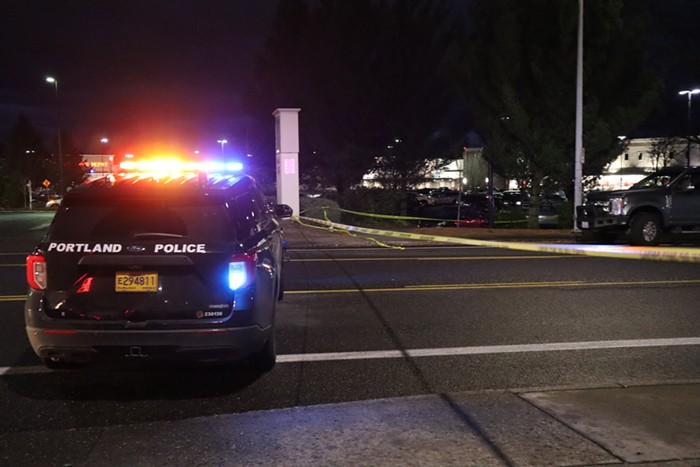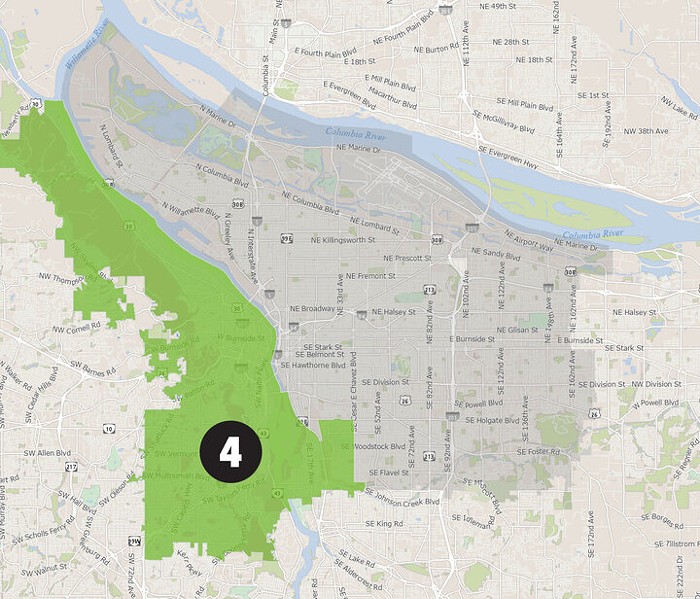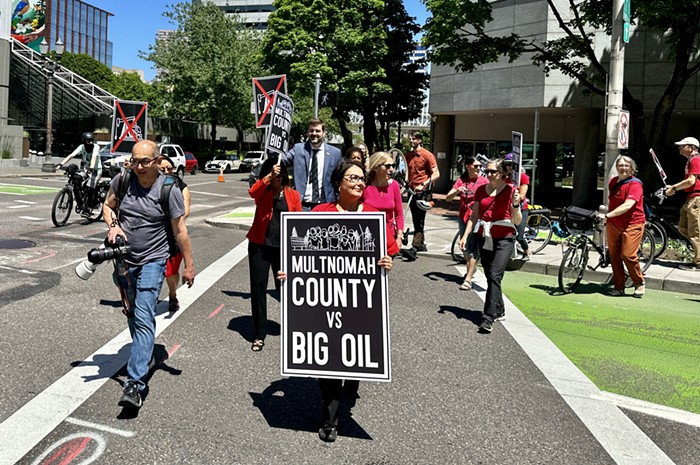YOU COULD BE forgiven for obsessing over oil trains.
Locomotives hauling black gold have shown a worrying predilection for igniting lately—with one especially terrible accident killing 47 in Quebec last year. Now, similar trains have begun moving through Oregon, and Portland, causing protests and alarm and media interest.
But if you've downed a Hefe-weizen at the Widmer Brothers Pub on North Russell, or meandered through the Central Eastside to scope a laser light show at the Oregon Museum of Science and Industry, or driven up Highway 30 to the St. Johns Bridge, chances are you've come far closer to potentially explosive, latently deadly chemicals than you ever will to a crude-splashed caboose.
Potential mayhem surrounds us at all times. The problem is no one's telling you about it.
For nearly three decades, federal law has given citizens the right to know which companies are storing large amounts of some of the world's most dangerous chemicals. But while state officials have successfully forced facilities to report their use of these so-called "extremely hazardous substances" to first responders, Oregon is almost comically behind in creating a framework for getting the word out to the people living and working near this stuff. What information can be gleaned from records requests is hard to parse.
The state and Multnomah County have only just begun to comply with a law the rest of the country has been largely following for 28 years. And local emergency planners and other experts are concerned even that's not being done effectively.
"Nobody cares that nobody knows what's 10 feet from your kids' schools," says Joe Partridge, a former deputy in the Multnomah County Office of Emergency Management. "How is that? I can't wrap my head around it."
PARTRIDGE IS EXAGGERATING, but not by much.
While it's true many of the Portland facilities holding dangerous compounds are in industrial enclaves—the industrial district along Highway 30, the Central Eastside, and the city's northern edge—they're not confined there.
That Hefe you drank at Widmer? It was poured directly across the street from two aboveground tanks of potentially explosive ammonia, according to records the Mercury obtained from the state fire marshal's office. Alpenrose Dairy, set up against tidy neighborhoods in Southwest Portland, reports that it has stored or is storing drums of peracetic acid, a highly corrosive substance also common in household cleaners. Boeing's Portland fabrication plant, just a short distance from a Fairview trailer park, says it uses four extremely hazardous compounds in batches great enough to merit reporting.
In total, Multnomah County hosts more than 200 facilities that store extremely hazardous substances (EHS)—a specially classified set of nasty chemicals—in excess of federal thresholds. Those facilities are split among nearly 130 companies, according to a Mercury analysis.
Many are hardly looming threats. Under the federal law, simply operating a couple of electric forklifts can put you above reporting thresholds, since the vehicles' batteries contain large amounts of sulfuric acid. Battery acid accounts for the majority of EHS reporting in Multnomah County.
Then there are more stereotypical sites. A facility run by the company Brentagg Pacific in Portland's sprawling Northwest industrial corridor reports storing six separate extremely hazardous substances—including combustible formaldehyde and poisonous hydrofluoric acid—according to the Mercury's analysis. The factory is listed in state records as a manufacturer of "cleaners and sanitizers," as well as a chemical distributor.
Portland, and Oregon as a whole, has been largely free of major industrial disasters like the fertilizer plant explosion that killed more than a dozen people in West, Texas, last year. And nearly everyone interviewed for this story pointed out Multnomah County's first responders are well positioned to handle the worst (though it's not remotely clear that's the case in other parts of Oregon).
Still, if tragedy does strike, officials agree, first responders shouldn't be the only ones in the know. Vulnerable communities—for instance, Northwest Portland's Linnton neighborhood, nestled among a great many hazardous material sites—should have a clue what they're dealing with. But largely because of Oregon's confused history when it comes to following federal regulations, most Portlanders have no idea.
"If people aren't aware they're living near these potentially dangerous locations," says Carmen Merlo, director of the Portland Bureau of Emergency Management, "they can't plan for it."
IN 1986, President Ronald Reagan signed bold new legislation aimed at ensuring all Americans could be prepared for the worst.
Spurred by two high-profile releases of deadly chemicals, the Emergency Planning and Community Right-to-Know Act (EPCRA) required companies to report storing noxious chemicals. In addition, emergency response plans would be filed with local committees all around the country, which were supposed to be peopled with a wide variety of stakeholders—elected officials, cops, journalists, environmental advocates, hospitals, and others.
The local bodies, known as LEPCs (Local Emergency Planning Committees), were at EPCRA's acronym-filled heart. They would help ensure industries had prudent plans in place and communicate potential dangers to the public.
Being mandatory, LEPCs have cropped up by the hundreds across the country. Partridge, the former Multnomah County emergency-planning deputy, spent eight years helping run one such group in Grand Rapids, Michigan. He says that committee of elected officials, planners, environmentalists, and other interested stakeholders was a proactive force.
Partridge recalls one Grand Rapids company involved in the group that used to unintentionally release chemicals in small amounts on a regular basis. Rather than just quietly report those releases, the company reached out to nearby residents.
"We're this company, we use this material," says Partridge, paraphrasing a pamphlet sent to homeowners. "It's important, but it's dangerous if it gets released. Here's what our plan is. Here's what you can do."
It wasn't a perfect system, Partridge says, but it worked.
"It gives you a place to go when you have concerns," he says. "At the very least you periodically get a reminder that you're at risk."
When Partridge took a job in the Multnomah County Office of Emergency Management in 2010, he assumed there was something similar to Grand Rapids' LEPC here.
He was horrified, he says, to find out just how wrong he was.
NEARLY THREE DECADES ago, state officials were actually ahead of the curve. In 1985, a full year before EPCRA, the Oregon Legislature passed a law requiring facilities to report their hazardous substances to the state. But when it comes to communicating that information to the public, the state has lagged behind.
From 1986 until 2007, officials saw fit to treat the whole of Oregon as one sprawling emergency district, with one LEPC coordinating planning and information for the entire state. That move is widely seen as a failure today.
"Every disaster that a community has is a local issue," says Mark Wallace, who served as Oregon's fire marshal until earlier this year. "It's hard to do great emergency planning on a statewide basis."
It wasn't until seven years ago that Oregon, under the banner of the state fire marshal's office, began looking at creating countywide planning districts. But progress has been slow.
Today, Oregon has just 10 LEPCs, covering 11 counties. The state's 25 other counties have no committee. That would seem to fly in the face of EPCRA requirements, although when pressed on that point recently, a spokesman for the US Environmental Protection Agency told the Mercury the feds have "not taken a position" on whether they could force Oregon into compliance.
In Multnomah County, an LEPC has been active since 2011, but it's hardly the robust and multi-disciplined institution mandated by Congress. Instead, the committee is largely made up of local industrial interests (who face penalties for not complying with federal law).
The group's chairman works at Siltronic, the silicone wafer manufacturer that helped bankroll the recent effort to snatch Portland's water and sewer utilities away from Portland City Hall. The vice chair works for Alpenrose Dairy, the secretary works for a Southeast Portland metal finishing company, and so on.
Local elected officials are absent from the Multnomah County LEPC's discussions, and many local emergency-planning officials attend sporadically, if at all. According to records obtained by the Mercury, industrial interests are almost the sole attendees of the group's meetings, though Portland Fire and Rescue and the Federal Bureau of Investigation are often on hand.
In the four meetings the Multnomah County LEPC held since the beginning of 2013, no media (other than a recent visit by the Mercury), environmental watchdogs, or many other interests mandated by the federal law have been in attendance. Only two members of the public appear to have attended—one of them being Partridge.
By contrast, tiny Columbia County has created a relatively vibrant LEPC—one chaired by emergency-response officials and attended by a wide variety of community members.
Neither Washington nor Clackamas County has an LEPC, a fact the director of Washington County's Emergency Management Cooperative finds worrisome.
"How do people know there's a [chemical] release? And what are they supposed to do?" asks the director, Scott Porter. "I can almost guarantee you that kind of planning hasn't occurred anywhere in the state."
In Multnomah County, LEPC leaders complain that they're laboring under an unfunded mandate, on volunteer time, and lack any real teeth to get people on board. A similar argument has been made by the state fire marshal's office.
"We don't have any authority" to force the creation of a LEPC, "but the law says there 'will' be a LEPC," says Sue Otjen who helps oversee EPCRA compliance at the fire marshal's office. "It's a Catch-22."
Still, the fire marshal's office is hoping to improve things. It recently created a taskforce that's looking to formalize the creation of LEPCs around the state.
There's a long way to go.
Three years after its creation, the Multnomah County LEPC is just beginning to reach out to companies that fail to meet federal reporting requirements. There is not yet a formal process for those companies to connect with the local committee, nor is it clear that many facilities even know they are expected to report.
Brian Bailey, the Siltronic employee who chairs the group, downplays that lack of reporting.
"There are emergency plans in place," he says. "There always have been."
But Bailey concedes the task before the group is huge, and made more difficult because the LEPC is staffed almost solely with industry interests, with few city or county bureaucrats to help encourage reporting.
"We basically were way behind the ball, considering [the state] did nothing," Bailey says. "I see this as just being the start of an organization. All beginning organizations have their floundering points."



















